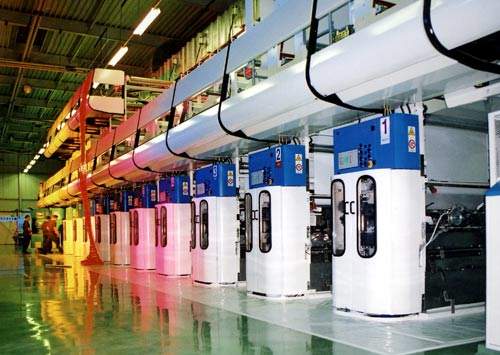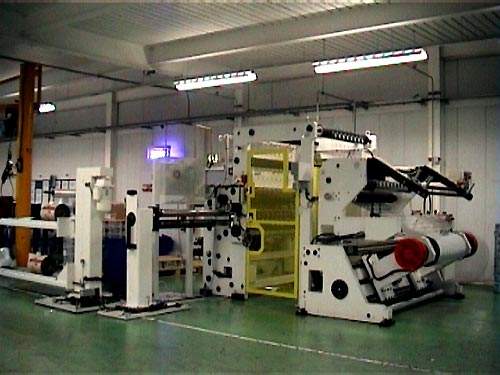The gravure industry, in common with other manufacturing industries, is having to face up to a future of not mass production but mass customisation. To address the growing trend for very short runs, fast response times and high print quality at a "mass produced" price, Amcor Flexibles initiated a project called Forge. The Forge concept is to print, by gravure, a high number of short run designs each day, while at the same time reducing lead times.
Because of its low cost base and its responsive and flexible culture, Amcor Flexibles S&R operation near Edinburgh, Scotland, was chosen to host Amcor’s first short run gravure operation based on the Forge concept. However, the plant closed in December 2010 after a fire accident in September 2010. Supplies to customers continue from other Amcor sites.
In February 2010, Amcor announced the launch of a new global brand to indicate the formation of a new company. The decision was taken following Amcor’s acquisition of the assets of Alcan Packaging on 1 February 2010. Fleetmark was contracted in late 2010 to rebrand Amcor vehicles in Australia with their new brand identity.
Amcor flexibles flexo and gravure packaging
Amcor Flexibles, one of Europe’s largest flexible package printers have flexo and gravure capability but are bucking this trend by offering short runs of gravure with a short lead time. One of the main reasons for this, according to Mr John Durston, deputy CEO of Amcor Flexibles, is a change in market positioning of own-label supermarket brands.
The major supermarkets have moved away from the original concept of low cost products in generic packaging to a growing demand for short runs of high quality own-label packaging. This is a potential growth market for gravure but needs a different approach to conventional gravure to meet the demands of the market in a cost effective manner.
Run length has always been a major determining factor when deciding whether a flexible packaging job is printed by flexo or gravure. Gravure has always been, and still is, well suited to long print runs where high, consistent, print quality is required, as is the case for global brands. However, the long lead-times and high origination cost historically associated with gravure, along with relatively high press set up times and make-ready scrap, have not lent the process well to the demand for short-run, fast-turnaround work.
Flexo on the other hand, with relatively fast, low cost origination and quick-change presses offering very low levels of set-up waste, has for many years now been able to offer cost advantages over gravure coupled with just-in-time production. This, along with greatly improved print quality, has helped flexo to expand its share of the flexible package print market considerably in recent years, much of which has been at the expense of gravure.
Forge production line and process equipment
Much of the production line philosophy of Forge has been adapted from the motor industry and the concept, which originates from visits by Amcor to Japan in the 1990s, is designed to drive out cost. This is achieved by standardisation or mass customisation to reduce complexity and by removing obstacles to fast response by developing new systems, procedures and practices. For example, substrates have been limited to a small number of material types and a limited number of web widths.
Amcor currently use PVdC coated film for biscuits and over-wraps, white film plus coldseal for countlines and OPP for confectionery and tobacco wraps. Amcor Flexibles’ materials partner is ExxonMobil, who have a vendor-managed inventory at the site. As the material specifications are based on the highest common factor, this means that there is sometimes a degree of over-specification and more edge trim waste than one would normally expect on some orders. However, overall the approach is said to be far more economical than dedicating different materials to different customers as a result of standardising materials more than offsets the increase in edge trim waste.
On the prepress side, time and cost have been removed from origination and the production of the gravure cylinders. Lightweight polymer sleeve cylinder bases, which offer a reduced cost and are also much easier to handle than conventional integral steel cylinder bases, are used for the production of electronically chromed copper gravure cylinders.
Keating Gravure is a key partner on this side of the operation and, as part of the arrangement, they also remove cylinders from the press and clean them at the end of the print run. All gravure cylinders are produced on site using a dedicated fully automatic engraving and chroming line, which features two Max Daetwyler Gravostar 850 engraving heads and is computer linked to Keating’s operation in Mold.
The GS 850 packaging engraver is a value-oriented unit, which includes a layout workstation, an engraver driver station and an engraver. It has a high frequency engraving head capable of engraving screens at up to 175 l/cm. As well as features such as telescopic enclosures, automatic lifting and lowering of the engraving head to prevent damage to the engraving head diamonds and on-board diagnostics the GS 850 also offers Daetwyler’s Vista cell sensing system.
The Vista system is used for head calibration and cell correction. Cells are measured on the fly, cell widths compared with the required widths and corrections made until the engraved cell is the right size. The system has a video monitor so that the user can see what the Vista camera sees and an optional printer that will output hard copy prints of the final cells for quality control purposes.
Other optional features include the TransCell Engraving system and the Transcribe system. The Transcell system places engraved cells at an optimum location rather than in the fixed grid normally associated with electromechanical engraving. This technique enables the production of high volume coarse screen engravings with enhanced edge definition. The Transcribe system enables the production of very fine high resolution type faces and other characters.
On the printing and converting side, dedicated Forge equipment includes a ten-colour Valmet Rotomec press and a Wickeltechnik 260 slitter. Lamination is carried out off-line on a Nordmeccanica solventless laminator. The press, which features and electronic line shaft (ELS), sleeved cylinders, automatic changing of print parts and automatic wash-up, is the heart of the Forge system.
The press is designed for very short-run gravure work and has the benefit of sleeved cylinders, automatic cylinder change and automatic wash-up. With the support of Keatings and full preparation of necessary materials for follow-up jobs prior to completion of a print run, the press is able to achieve very short set-up times. The press is also able to achieve faster registration and less set-up waste than a conventional long-run press. Flint Schmidt supplies ink to the press and is committed to minimising colour matching time. On occasions this has been achieved in ten minutes.
Amcor flexibles forge staffing
Forge is not just about equipment. Central to the Forge concept is the approach to manpower. The Forge teams all visited Japan for a week to train alongside Japanese operators and study systems first-hand.
Short run gravure
With the Forge approach Amcor is able to offer end-users cost-effective short run gravure with short lead times at a cost-effective price, slitter rewinder and cylinder store. It is also a service that importers of gravure printed material cannot match.






